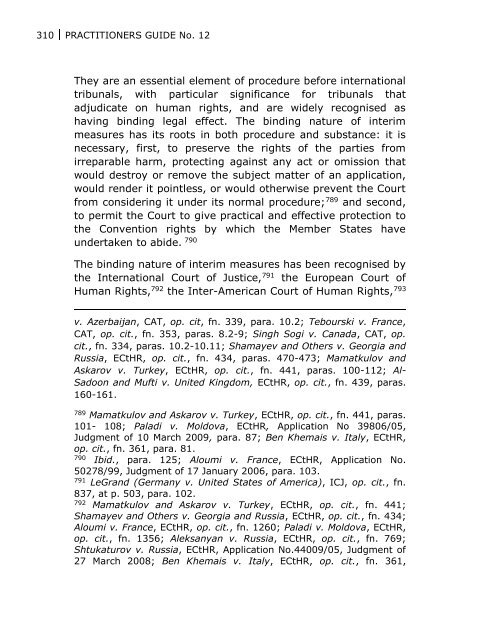Universal-Womens-accesss-to-justice-Publications-Practitioners-Guide-Series-2016-ENG
Universal-Womens-accesss-to-justice-Publications-Practitioners-Guide-Series-2016-ENG
Universal-Womens-accesss-to-justice-Publications-Practitioners-Guide-Series-2016-ENG
Create successful ePaper yourself
Turn your PDF publications into a flip-book with our unique Google optimized e-Paper software.
310 PRACTITIONERS GUIDE No. 12<br />
They are an essential element of procedure before international<br />
tribunals, with particular significance for tribunals that<br />
adjudicate on human rights, and are widely recognised as<br />
having binding legal effect. The binding nature of interim<br />
measures has its roots in both procedure and substance: it is<br />
necessary, first, <strong>to</strong> preserve the rights of the parties from<br />
irreparable harm, protecting against any act or omission that<br />
would destroy or remove the subject matter of an application,<br />
would render it pointless, or would otherwise prevent the Court<br />
from considering it under its normal procedure; 789 and second,<br />
<strong>to</strong> permit the Court <strong>to</strong> give practical and effective protection <strong>to</strong><br />
the Convention rights by which the Member States have<br />
undertaken <strong>to</strong> abide. 790<br />
The binding nature of interim measures has been recognised by<br />
the International Court of Justice, 791 the European Court of<br />
Human Rights, 792 the Inter-American Court of Human Rights, 793<br />
v. Azerbaijan, CAT, op. cit, fn. 339, para. 10.2; Tebourski v. France,<br />
CAT, op. cit., fn. 353, paras. 8.2-9; Singh Sogi v. Canada, CAT, op.<br />
cit., fn. 334, paras. 10.2-10.11; Shamayev and Others v. Georgia and<br />
Russia, ECtHR, op. cit., fn. 434, paras. 470-473; Mamatkulov and<br />
Askarov v. Turkey, ECtHR, op. cit., fn. 441, paras. 100-112; Al-<br />
Sadoon and Mufti v. United Kingdom, ECtHR, op. cit., fn. 439, paras.<br />
160-161.<br />
789<br />
Mamatkulov and Askarov v. Turkey, ECtHR, op. cit., fn. 441, paras.<br />
101- 108; Paladi v. Moldova, ECtHR, Application No 39806/05,<br />
Judgment of 10 March 2009, para. 87; Ben Khemais v. Italy, ECtHR,<br />
op. cit., fn. 361, para. 81.<br />
790<br />
Ibid., para. 125; Aloumi v. France, ECtHR, Application No.<br />
50278/99, Judgment of 17 January 2006, para. 103.<br />
791<br />
LeGrand (Germany v. United States of America), ICJ, op. cit., fn.<br />
837, at p. 503, para. 102.<br />
792<br />
Mamatkulov and Askarov v. Turkey, ECtHR, op. cit., fn. 441;<br />
Shamayev and Others v. Georgia and Russia, ECtHR, op. cit., fn. 434;<br />
Aloumi v. France, ECtHR, op. cit., fn. 1260; Paladi v. Moldova, ECtHR,<br />
op. cit., fn. 1356; Aleksanyan v. Russia, ECtHR, op. cit., fn. 769;<br />
Shtukaturov v. Russia, ECtHR, Application No.44009/05, Judgment of<br />
27 March 2008; Ben Khemais v. Italy, ECtHR, op. cit., fn. 361,



